Miller
General Hospital
Greenwich High Road, SE10
Medical
dates:
Medical
character:
Acute
The precursor to the Hospital
was the Kent Dispensary, which opened in a house in the Broadway,
Deptford, in 1783.
In 1837 Queen Victoria agreed to be its patroness and the name was changed to the Royal Kent Dispensary.
In 1851 the Dispensary was forced to move and a new building in Greenwich High Road was completed for it in 1855.
To celebrate the centenary of the Dispensary in 1883, it was decided to build a hospital. This was intended also to be a memorial to the Revd Canon John Cale Miller (1814-1880), the founder of Hospital Sunday, who had been Vicar of St Alfege, Greenwich, at the time of his death and had greatly supported the work of the Dispensary.
The Miller Memorial Hospital opened in December 1884, built in the grounds of the Dispensary. Its 25 beds served a population of over 510,000. It was the first hospital in Great Britain to have circular wards, which supposedly allowed better ventilation (i.e. there were no corners to harbour germs). The wards, named John Penn Ward and Beatrice Ward, were 35 feet (11 metres) in diameter and had 10 beds each.
In April 1898 a new temporary wing was officially opened by the philanthropist John Passmore Edwards (1823-1911). It was urgently needed for the accommodation of out-patients, of whom 50 to 60 were treated daily, until a permanent building could be funded for the purpose.
In 1908 the Hospital was renamed the Miller General Hospital for South East London. The Hospital Committee purchased a piece of land and properties abutting upon the buildings of the Hospital, which would be used for future extension.
In July 1911 the foundation stone for a new wing was laid by William Heneage Legge, 6th Earl of Dartmouth (1851-1936).
The William Bucknell Wing opened in 1912. The building was officially opened on 15th November by Princess Louise, Duchess of Argyll (1848-1939).
The new wing increased the bed complement to 76. It contained three wards - the Annie Zunz Ward, the Norfolk Ward (named after Mrs Charles Norfolk) and the Restell Ward (after Mr Thomas Miles Restell, who had died in 1899. By his will the sum of £5,000 would be paid to the Hospital on the death of his surviving widow. She died in 1927).
In 1912 Sir Ernest Cassel gave £1,000 to the Hospital in memory of his daughter, Mrs Maude Ashley. A bed was named after her (and a second bed in 1916). The two large wards, one for men and one for women, were already occupied by patients receiving medical and surgical treatment. Each ward had a bathroom by the entrance lobby, instead of the usual practice of placing it at the far end. A small ward for one patient was also by the lobby, as was the ward kitchen and linen room.
The ward floors were of black and white terrano, a lightweight, fire-proof, water-proof and rat-proof jointless flooring resembling a fine linoleum. It was difficult to keep satisfactorily clean and it was suggested that an expert would have to be hired at 30 shillings (£1.50) a week to clean it. The corridors were paved with terrazzo, which was not so difficult to clean but, in fact, cleaning of such a large area of floor and wall space in the new block required a great amount of labour by the domestic department.
The lower half of the central lights of the wards were shaded, producing a subdued and pleasant effect. The shades for lights over the patients' beds came from America.
Meals for the patients were brought to the wards in dinner wagons, the tops of which served as hot plates.
The top floor of the new 4-storey building was devoted to the operating room and its annexes, including a bathroom for the surgeons (the first such to be provided in a hospital in England). The X-ray Department was located in the basement. The new block, with 51 beds, had cost £23,000 to build and equip, of which £7,000 still had to be raised.
During WW1 the Hospital made 10-20 beds available for wounded and sick servicemen. By December 1914 they were all occupied. In 1916 Mrs Pauline Paget, wife of Almeric Paget (later 1st Baron Queenborough) opened a large Massage Department.
On 21st September 1917 the Hospital took over the Mission Convalescent Home in Amherst Road, Bexhill, which had belonged to the Deptford Medical Mission. It had 14 beds and was renamed the Miller General Hospital Convalescent Home (From 24th February 1931 it became known as the Fountain Convalescent Home. It was closed during WW2 and then requisitioned by the Bexhill Corporation for housing).
After the war two beds at the Hospital were endowed by the Bellingham Bowling and Lawn Tennis Club. As a war memorial, a stone tablet was placed above each bed inscribed with the names of those members and their sons who had been killed during WW1 (the tablets were lost when the Hospital was demolished).
At the end of the 1920s the Hospital received funds from the remaining moneys raised for the Greenwich War Memorial in Blackheath, which was distributed to the hospitals of the Borough.
In 1928 the Robinson Wing was built. It was named after John Henry Robinson, the Chairman of the Hospital from 1906 to 1931. The
Hospital then had 151 beds.
The new wards were named after Mr and
Mrs John Morris (Morris Ward) and William Shepherd (Shepherd Ward).
The new Children's Ward was opened by the Duchess
of York in May
1929. It had been built and equipped with £5,000 raised as
a tribute to the war dead. The Duchess also unveiled the Borough
of Deptford War Memorial tablet placed in a corridor of the new
building.
A new operating theatre had been installed on the top floor of
the Bucknell Wing, and a Nurses' Home built in Catherine Grove.
In 1935 a new 16-bedded ward - the McDougall Ward named after Mr James McDougall, a member of the Hospital Board who had left £10,000 to the Hospital in his will - was built on the roof of the Robinson Wing. It was opened on 18th July by the Honorary Treasurer, General Sir Aylmer Haldane. The Hospital then had 167 beds, a Casualty Department and 18 specialist out-patients departments, namely, medical, surgical, children's ophthalmic, nose throat and ear, gynaecological, electrical, orthopaedic, genitourinary, pathological, dermatological, X-ray, dental, venereal diseases, massage, Swedish remedial, ultraviolet ray (artificial sunlight) and psychological medicine.
The weekly cost of an in-patient was £3 8s 7d (£3.43) in 1935, compared with £3 6s 4d (£3.32) in 1934. A silver paper collection in 1935 had raised some £133 14s 9d (£133.74) for the Hospital. Arrangements were made with the Schiff Home to send female patients there for convalescence, while children were send to the Fountain Convalescent Home for Children in Bexhill-on-Sea, which had 16 cots. Patients there remained an average of 43 days at a weekly cost of £1 8s 8d (£1.43).
A new
Out-Patients Department opened in the late 1930s.
During WW2 the Hospital joined the Emergency Medical Service, reserving 10 of its 172 beds for civilian or military casualties. The Hospital was adopted by the Chattanooga Branch of Bundles for Britain, Inc. for the duration of the war.
The Pauline Paget Ward opened in 1947. It was named after the wife of Almeric Paget, 1st Baron Queenborough, and President of the Hospital. The weekly cost of an in-patient was £9 16s 11d (£9.85), with most patients staying on average 16 days.
The Hospital joined the NHS in 1948, together with St Alfege's Hospital, under the control of the Greenwich and Deptford Hospital Management Committee, part of the South East Metropolitan Regional Hospital Board. It had 180 beds.
In 1949 the Almeric Paget Physiotherapy and Rehabilitation Department closed. It had been maintained since May 1916 by Lady Baillie and Dorothy Paget, the daughters of Almeric Paget. During its operational lifetime, the Department had provided massage, electrical, Swedish remedial, radiant heart and ultraviolet ray treatments, at a cost of over £70,000 to the Almeric Paget Trust.
In 1965 the Hospital was absorbed by Greenwich District Hospital and became its Miller General Wing.
It was considered too expensive (an estimated £600,000) to modernise the facilities and it closed in 1974, despite protests from the staff and local community, who had collected a petition of 12,000 signatures against the move. Services were transferred to the new Miller Wing of the Greenwich District Hospital.
In 1837 Queen Victoria agreed to be its patroness and the name was changed to the Royal Kent Dispensary.
In 1851 the Dispensary was forced to move and a new building in Greenwich High Road was completed for it in 1855.
To celebrate the centenary of the Dispensary in 1883, it was decided to build a hospital. This was intended also to be a memorial to the Revd Canon John Cale Miller (1814-1880), the founder of Hospital Sunday, who had been Vicar of St Alfege, Greenwich, at the time of his death and had greatly supported the work of the Dispensary.
The Miller Memorial Hospital opened in December 1884, built in the grounds of the Dispensary. Its 25 beds served a population of over 510,000. It was the first hospital in Great Britain to have circular wards, which supposedly allowed better ventilation (i.e. there were no corners to harbour germs). The wards, named John Penn Ward and Beatrice Ward, were 35 feet (11 metres) in diameter and had 10 beds each.
In April 1898 a new temporary wing was officially opened by the philanthropist John Passmore Edwards (1823-1911). It was urgently needed for the accommodation of out-patients, of whom 50 to 60 were treated daily, until a permanent building could be funded for the purpose.
In 1908 the Hospital was renamed the Miller General Hospital for South East London. The Hospital Committee purchased a piece of land and properties abutting upon the buildings of the Hospital, which would be used for future extension.
In July 1911 the foundation stone for a new wing was laid by William Heneage Legge, 6th Earl of Dartmouth (1851-1936).
The William Bucknell Wing opened in 1912. The building was officially opened on 15th November by Princess Louise, Duchess of Argyll (1848-1939).
The new wing increased the bed complement to 76. It contained three wards - the Annie Zunz Ward, the Norfolk Ward (named after Mrs Charles Norfolk) and the Restell Ward (after Mr Thomas Miles Restell, who had died in 1899. By his will the sum of £5,000 would be paid to the Hospital on the death of his surviving widow. She died in 1927).
In 1912 Sir Ernest Cassel gave £1,000 to the Hospital in memory of his daughter, Mrs Maude Ashley. A bed was named after her (and a second bed in 1916). The two large wards, one for men and one for women, were already occupied by patients receiving medical and surgical treatment. Each ward had a bathroom by the entrance lobby, instead of the usual practice of placing it at the far end. A small ward for one patient was also by the lobby, as was the ward kitchen and linen room.
The ward floors were of black and white terrano, a lightweight, fire-proof, water-proof and rat-proof jointless flooring resembling a fine linoleum. It was difficult to keep satisfactorily clean and it was suggested that an expert would have to be hired at 30 shillings (£1.50) a week to clean it. The corridors were paved with terrazzo, which was not so difficult to clean but, in fact, cleaning of such a large area of floor and wall space in the new block required a great amount of labour by the domestic department.
The lower half of the central lights of the wards were shaded, producing a subdued and pleasant effect. The shades for lights over the patients' beds came from America.
Meals for the patients were brought to the wards in dinner wagons, the tops of which served as hot plates.
The top floor of the new 4-storey building was devoted to the operating room and its annexes, including a bathroom for the surgeons (the first such to be provided in a hospital in England). The X-ray Department was located in the basement. The new block, with 51 beds, had cost £23,000 to build and equip, of which £7,000 still had to be raised.
During WW1 the Hospital made 10-20 beds available for wounded and sick servicemen. By December 1914 they were all occupied. In 1916 Mrs Pauline Paget, wife of Almeric Paget (later 1st Baron Queenborough) opened a large Massage Department.
On 21st September 1917 the Hospital took over the Mission Convalescent Home in Amherst Road, Bexhill, which had belonged to the Deptford Medical Mission. It had 14 beds and was renamed the Miller General Hospital Convalescent Home (From 24th February 1931 it became known as the Fountain Convalescent Home. It was closed during WW2 and then requisitioned by the Bexhill Corporation for housing).
After the war two beds at the Hospital were endowed by the Bellingham Bowling and Lawn Tennis Club. As a war memorial, a stone tablet was placed above each bed inscribed with the names of those members and their sons who had been killed during WW1 (the tablets were lost when the Hospital was demolished).
At the end of the 1920s the Hospital received funds from the remaining moneys raised for the Greenwich War Memorial in Blackheath, which was distributed to the hospitals of the Borough.
In 1928 the Robinson Wing was built. It was named after John Henry Robinson, the Chairman of the Hospital from 1906 to 1931.
In 1935 a new 16-bedded ward - the McDougall Ward named after Mr James McDougall, a member of the Hospital Board who had left £10,000 to the Hospital in his will - was built on the roof of the Robinson Wing. It was opened on 18th July by the Honorary Treasurer, General Sir Aylmer Haldane. The Hospital then had 167 beds, a Casualty Department and 18 specialist out-patients departments, namely, medical, surgical, children's ophthalmic, nose throat and ear, gynaecological, electrical, orthopaedic, genitourinary, pathological, dermatological, X-ray, dental, venereal diseases, massage, Swedish remedial, ultraviolet ray (artificial sunlight) and psychological medicine.
The weekly cost of an in-patient was £3 8s 7d (£3.43) in 1935, compared with £3 6s 4d (£3.32) in 1934. A silver paper collection in 1935 had raised some £133 14s 9d (£133.74) for the Hospital. Arrangements were made with the Schiff Home to send female patients there for convalescence, while children were send to the Fountain Convalescent Home for Children in Bexhill-on-Sea, which had 16 cots. Patients there remained an average of 43 days at a weekly cost of £1 8s 8d (£1.43).
During WW2 the Hospital joined the Emergency Medical Service, reserving 10 of its 172 beds for civilian or military casualties. The Hospital was adopted by the Chattanooga Branch of Bundles for Britain, Inc. for the duration of the war.
The Pauline Paget Ward opened in 1947. It was named after the wife of Almeric Paget, 1st Baron Queenborough, and President of the Hospital. The weekly cost of an in-patient was £9 16s 11d (£9.85), with most patients staying on average 16 days.
The Hospital joined the NHS in 1948, together with St Alfege's Hospital, under the control of the Greenwich and Deptford Hospital Management Committee, part of the South East Metropolitan Regional Hospital Board. It had 180 beds.
In 1949 the Almeric Paget Physiotherapy and Rehabilitation Department closed. It had been maintained since May 1916 by Lady Baillie and Dorothy Paget, the daughters of Almeric Paget. During its operational lifetime, the Department had provided massage, electrical, Swedish remedial, radiant heart and ultraviolet ray treatments, at a cost of over £70,000 to the Almeric Paget Trust.
In 1965 the Hospital was absorbed by Greenwich District Hospital and became its Miller General Wing.
It was considered too expensive (an estimated £600,000) to modernise the facilities and it closed in 1974, despite protests from the staff and local community, who had collected a petition of 12,000 signatures against the move. Services were transferred to the new Miller Wing of the Greenwich District Hospital.
Present status (January
2008)
Most of the Hospital was demolished in 1975, although the original Dispensary, General Wing building and Nurses' Home have survived.
The site has recently been redeveloped by Bellway Homes Ltd. It now contains a new block along Greenwich High Road - Ashburham Apartments.
Most of the Hospital was demolished in 1975, although the original Dispensary, General Wing building and Nurses' Home have survived.
The site has recently been redeveloped by Bellway Homes Ltd. It now contains a new block along Greenwich High Road - Ashburham Apartments.
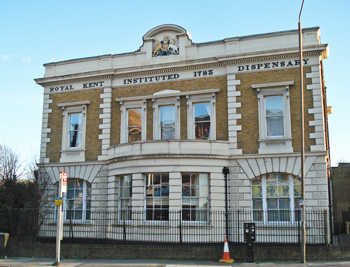
The original Royal Kent Dispensary building is now Grade II listed (above and below). It has been converted into an apartment block.
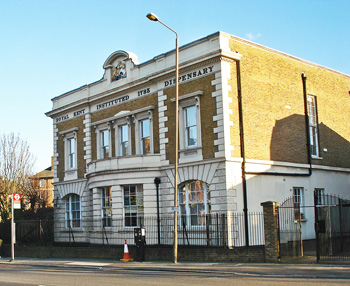

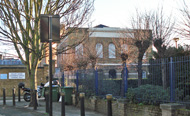
The Grade II listed chapel, built in 1801, became the General Wing of the Hospital. It was used as the Rehabilitaton Department.
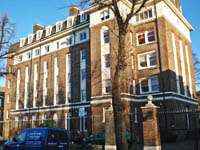

The Nurses' Home in Catherine Grove is now Dartmouth House, an apartment block.
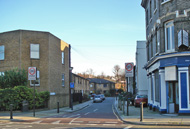
Looking down Burgos Grove into the heart of the Hospital site.
War Memorial tablets
The tablets were lost when the Hospital was demolished.
Inscription on the Borough of Greenwich War Memorial tablet displayed in the corridor of the 1928 Robinson Wing:
The tablets were lost when the Hospital was demolished.
Inscription on the Borough of Greenwich War Memorial tablet displayed in the corridor of the 1928 Robinson Wing:
| In glorious and grateful memory of the members of the Borough of Greenwich who gave their lives in the Great War 1914-1918, a large sum of money was subscribed in response to an appeal during the Mayoralty of Sir Charles Stone, J.P., to be devoted (after providing for the erection of the War Memorial on Blackheath) to the purposes of Hospitals in the Borough. The money given and allocated to this Hospital has been applied towards the erection of this Ward Block. |
Inscription on the
tablet at the entrance of the Children's Ward:
| Borough of Deptford
War Memorial Children's Ward As a tribute to memory of her gallant citizens who fell in the Great War 1914-1918, the inhabitants of the Borough of Deptford have subscribed a sum of £5,000 raised during the Mayoralty of Lt. Col. Alderman Sir William Wayland as the initial contribution towards the erection and equipment of this Children's Ward. |
(Author unstated) 1898 Reflections from a Board Room mirror. The Nursing Record and Hospital World, 25th April, 339.
(Author unstated) 1908 Reflections from a Board Room mirror. British Journal of Nursing, 16th May, 396.
(Author unstated) 1912 Reflections from a Board Room mirror. British Journal of Nursing, 2nd November, 360.
(Author unstated) 1912 The Miller General Hospital, S.E. British Journal of Nursing, 16th November, 400-401.
Taylor J 1988 Circular hospital wards. Medical History 32, 426-448.
(Accessed 23rd August 2013)
http://hansard.millbanksystems.com
www.aim25.ac.uk
www.britishlistedbuildings.co.uk (1)
www.britishlistedbuildings.co.uk (2)
www.greenwich-guide.org.uk
www.nationalarchives.gov.uk
Return to home page